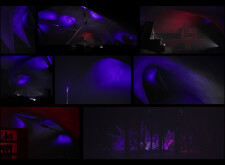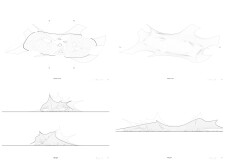5 key facts about this project
### Project Overview
"Samsust: Tensile Silence" is positioned within the Sansusi Festival landscape and explores the concepts of sound and silence through an immersive architectural environment. The design facilitates interactions between musicians and audiences, creating a multi-sensory experience that underscores the importance of silence as an active element in the perception of sound. Through a careful interpretation of musical notation and its visual representation, the project seeks to embody musicality within its structural form.
### Architectural Form and Spatial Strategy
The architectural form is characterized by a series of undulating shapes that mimic the dynamic qualities of musical sound, featuring both sharp peaks and smooth curves. This design employs tension and compression techniques to fashion a structure that evolves in response to the performance dynamics. The spatial organization encourages movement and interaction, with overlapping areas that foster engagement between performers and their audience. A promenade encircles two distinct stages, promoting a fluid relationship between music and the surrounding natural environment, while organically arranged seating caters to varied performance scales and configurations, enhancing versatility.
### Materiality and Environmental Integration
High-strength tensile fabric is utilized for its lightweight and adaptable qualities, allowing the structure to coexist harmoniously with its forest setting. The reflective properties of the materials amplify the interplay of light and shade, contributing to the overall ambiance during performances. Additionally, the integration of wood and stone elements in peripheral seating and bar areas roots the design in its natural context, offering tactile experiences for visitors. By employing light materials, the project minimizes its ecological footprint, promoting a sustainable approach while respecting the local environment and cultural significance inherent to the Sansusi Festival.






















































